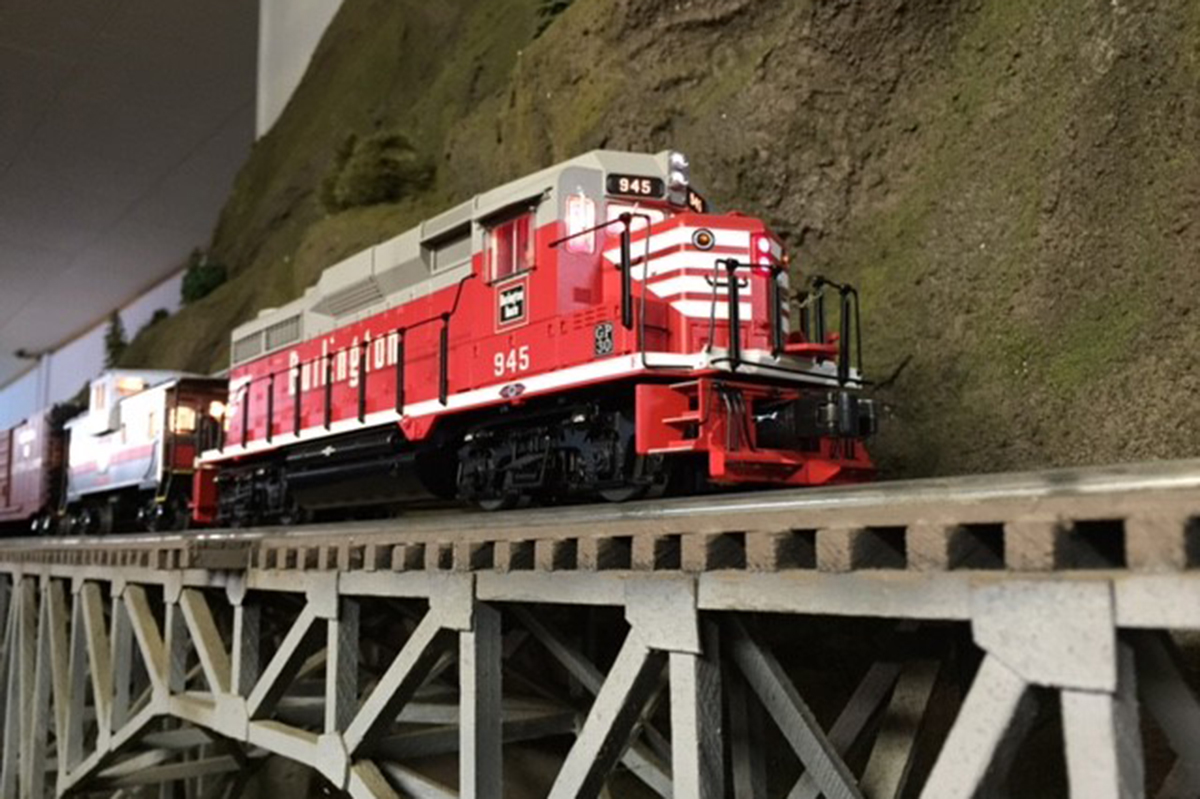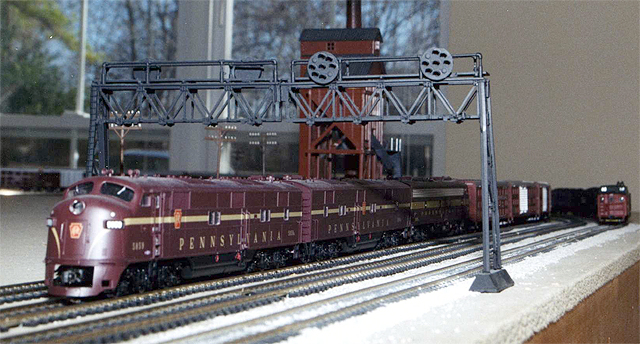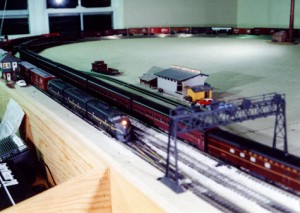Chapter members and modelers gather at one of Keith Kittinger’s Train Nights at his garage HO layout May 2, 2016. Photos by Ricky Bivins


Rick Bivins’ model mountain and bridge in process and after his friend Josh added some color. Click on photos to view larger. – Photos by Rick Bivins
 In the Spring of 1961, PRR hotshot NF-6 (“Non-Feed”), a livestock schedule from Chicago to Harsimus Cove, NJ, passes under the signal bridge at MP 127.7, just west of Orrville, OH on the Pittsburgh-Chicago main line. With cuts and consolidations in the railroad’s still massive passenger network, the PRR has taken advantage of surplus passenger power to assign E-units to the train on this day, suiting the high-speed nature of the schedule. In the distance, a westbound loaded coal train (“mineral train” in PRR terms) heads for the Lake Erie docks at Sandusky, OH. Submitted by Fred Ripley – photos on his Pennsylvania Layout.
In the Spring of 1961, PRR hotshot NF-6 (“Non-Feed”), a livestock schedule from Chicago to Harsimus Cove, NJ, passes under the signal bridge at MP 127.7, just west of Orrville, OH on the Pittsburgh-Chicago main line. With cuts and consolidations in the railroad’s still massive passenger network, the PRR has taken advantage of surplus passenger power to assign E-units to the train on this day, suiting the high-speed nature of the schedule. In the distance, a westbound loaded coal train (“mineral train” in PRR terms) heads for the Lake Erie docks at Sandusky, OH. Submitted by Fred Ripley – photos on his Pennsylvania Layout.

A pair of SBD SDs are framed by a steel bridge on Chapter member Keith Kittinger’s new model railroad he is developing in his garage/building.

 Just before 10:00 PM on a June night in 1960, the 4-track PRR Pittsburgh-Chicago main line at Smithville, OH (MP 129.5 west of Pittsburgh) presents this scene. Facing the camera behind an A-B-A set of EF-15’s (the PRR’s name for F3’s) comes Advance WC-5/7, one of the “WC” fleet of westbound freights from the huge yard at Conway, PA. The WC schedules are designed to expedite interchange traffic, pre-blocked at Conway for delivery to western roads at Chicago. Going away, on No. 2 track, is No. 48, the eastbound General, second only to the all-Pullman Broadway Limited (following less than an hour behind the General) in priority. No. 48, with 3 EP-20’s (E7’s) and 16 cars, has just crested the 1% grade of Wooster Hill, and will maintain the posted speed of 70 mph to the next stop at Canton. The General is named for 1930’s PRR president W. W. Atterbury, who was director of rail operations for the American Expeditionary Force in France in 1918, and although a civilian used the title “General” for the rest of his life.
Just before 10:00 PM on a June night in 1960, the 4-track PRR Pittsburgh-Chicago main line at Smithville, OH (MP 129.5 west of Pittsburgh) presents this scene. Facing the camera behind an A-B-A set of EF-15’s (the PRR’s name for F3’s) comes Advance WC-5/7, one of the “WC” fleet of westbound freights from the huge yard at Conway, PA. The WC schedules are designed to expedite interchange traffic, pre-blocked at Conway for delivery to western roads at Chicago. Going away, on No. 2 track, is No. 48, the eastbound General, second only to the all-Pullman Broadway Limited (following less than an hour behind the General) in priority. No. 48, with 3 EP-20’s (E7’s) and 16 cars, has just crested the 1% grade of Wooster Hill, and will maintain the posted speed of 70 mph to the next stop at Canton. The General is named for 1930’s PRR president W. W. Atterbury, who was director of rail operations for the American Expeditionary Force in France in 1918, and although a civilian used the title “General” for the rest of his life.